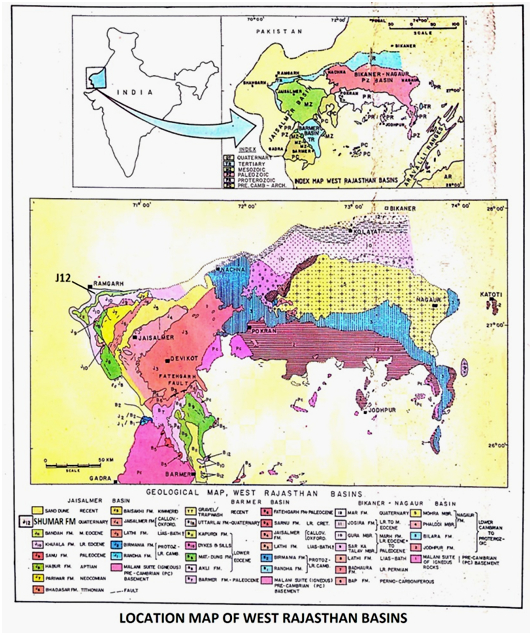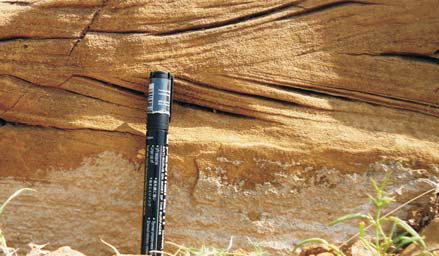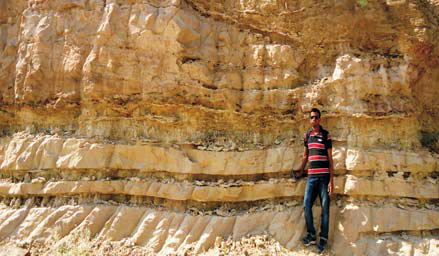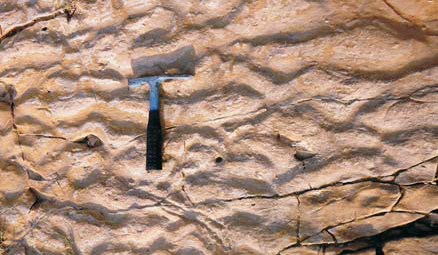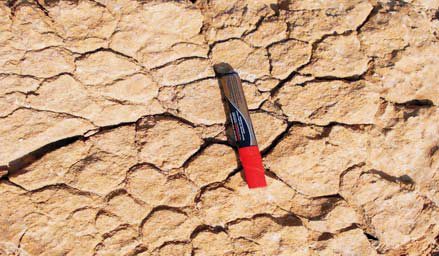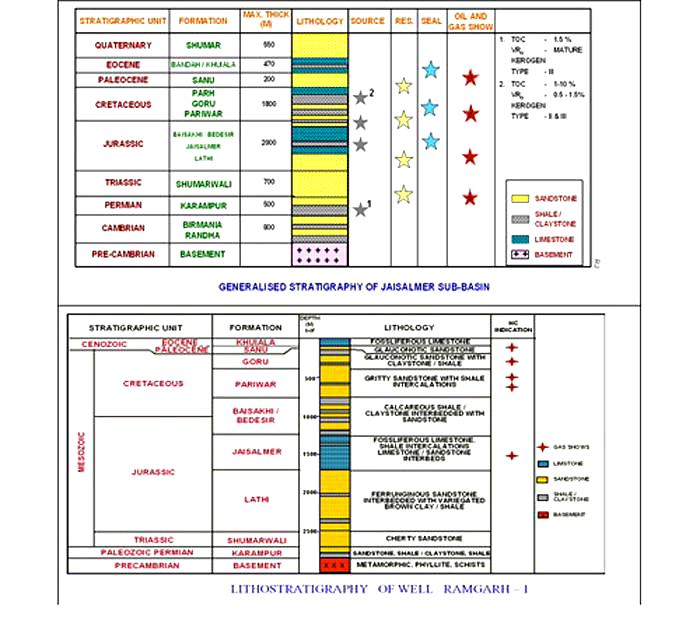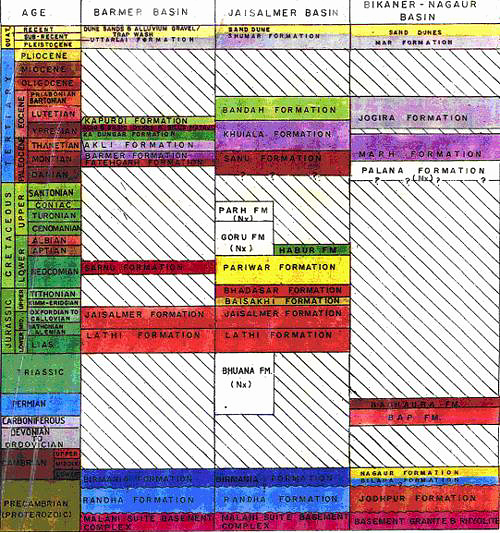Jaisalmer Fm
Type Locality and Naming
OUTCROP. The formation is well exposed in southeastern part of Jaisalmer-Mari High around Jaisalmer Town. A more or less complete section of the formation is exposed on the southern flank of Dujero Dungar anticline. However, the entire formation with well developed, different members is not exposed at one place due to isolated, eroded and horizontally bedded outcrops, therefore two or three localities have been selected to reconstruct the formation from base to top. Important localities are northwest of Thaiat, Hamira, around Jaisalmer city and Kuldhar. In subsurface, Ghotaru area and Sattarwali well sections are taken as reference sections. [Original Publication: Swaminath, J., Krishnamurthy, J.G., Verma, K.K., and Chandak, G.J., 1959, General geology of Jaisalmer area, Rajasthan, ECAFE Symposium, Mineral Research and Development Series 10: 154-155]
Synonyms: The formation was first described by Oldham (1886) as "Jaisalmer Limestone" without mentioning the type section and limiting boundaries. Allison (1939) named it "Jaisalmer Group". Subsequently, Swaminath et al. (1959) formalized this unit as "Jaisalmer Formation" and redefined upper boundary but did not mention the type area. Narayanan et al. (1961) and Dasgupta (1975) gave further details of the formation and identified its type localities.
Lithology and Thickness
Limestone. It is mainly represented by yellow colored hard, fossiliferous limestone with interbeds of calcareous sandstone. Dasgupta (1975) subdivided the formation into five members: Hamira, Joyan, Fort, Badabag, and Kuldhar.
[Figure 1: Stratotype of Jaisalmer Formation, Mesozoic Lithostratigraphy of the Jaisalmer Basin, Rajasthan, Journal of the Paleontological Society of India, Vol. 51(2) (after Singh N.P, 2006)]
[Figure 2: Field photograph showing Cross-bedding in 1.5m thick medium to coarse-grained sandstones of Jaisalmer Formation, Depositional environment of the Fort Member of the Jurassic Jaisalmer Formation (western Rajasthan, India)(after F. Ahmad et al., 2017)]
[Figure 3: Field photograph showing Interbedded shales within the thinly bedded fine- grained sandstones, interbedded reddish white shales are of variable thickness, Depositional environment of the Fort Member of the Jurassic Jaisalmer Formation (western Rajasthan, India) (after F. Ahmad et al., 2017)]
[Figure 4: Field photograph showing asymmetrical ripple marks with ripple wavelength range from 6cm to 12cm of Jaisalmer Formation, Depositional environment of the Fort Member of the Jurassic Jaisalmer Formation (western Rajasthan, India) (after F. Ahmad et al., 2017)]
[Figure 5: Field photograph showing tabular and rippled top mud cracks of Jaisalmer Formation, Depositional environment of the Fort Member of the Jurassic Jaisalmer Formation (western Rajasthan, India) (after F. Ahmad et al., 2017)]
[Figure 6: Generalized and Subsurface Stratigraphy of Jaisalmer Basin (from dghindia.gov.in)]
Relationships and Distribution
Lower contact
It is conformable, gradational and intertonguing both in outcrops as well as in subsurface sections. In outcrops, dull orange, red to yellow claystone bands represent the lower limit of the formation with underlying Lathi Fm.
Upper contact
The contact between the Jaisalmer Fm and the overlying Baisakhi Fm is not very clear in outcrops, although it has conformable relationship. However, a sharp facies change from oolitic limestone of the Jaisalmer Fm to gypsiferous clays of the Baikashi Fm has been noticed near Kildhar Village. In subsurface, upper boundary is placed between oolitic limestone and glauconitic, plastic clays exhibiting identical condition with that of outcropping area.
GeoJSON
Fossils
From the outcropping Kuldhar Member of the formation, Hoffman (referred by Rithor-Bernburg and Schott, 1957) identified several ammonite species such as Reineckia, cf, R. Waggeni, Indosphinctes sp. Kinkeliniceras sp., Mayaitis sp, Dhosaites aff. D. otoitoides etc. Turitella sp. and Ostrea marshi were also recorded along with above cephalopods.
Dave and Chatterjee (1996) recorded smaller benthies from Fort Member to Kuldhar Member of the formation and recognized four biostratigraphic zones namely Tewaria sp-Dorothia poddari assemblage zone, Lenticulina discipiens range zone, Tewaraia kutchensis partial range zone and Epistomina mosquensis range zone referable to lower Bathonian. Early Callovian, Middle Callovian and middle Late Callovian. However, Srivatsava et al. (1995) recorded Tewaria sp from this sequence along with non-diagnostic taxa, which suggests Middle Jurassic (Bathonian) age. The top most oolitic limestone of the formation is comparatively soft and yielded interesting foraminifer assemblage comprising Nautiloculina oolithica, Trocholina cf. transversarii, T. cf. conosimilis, T. cf. elevata, Conicospirillina basiliensis and Pseudocyclamina virguliana. This assemblage suggest same age as that of Subbotina et.al (1960).
Age
Depositional setting
Open-marine conditions.
Additional Information
